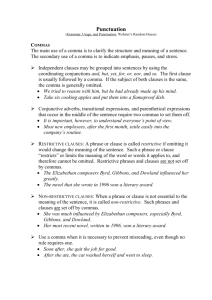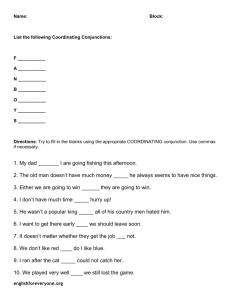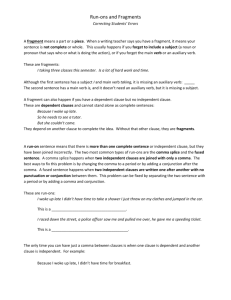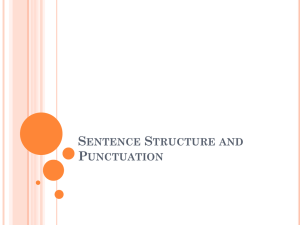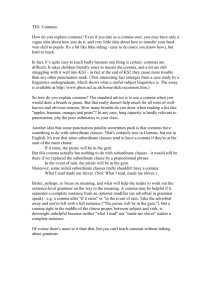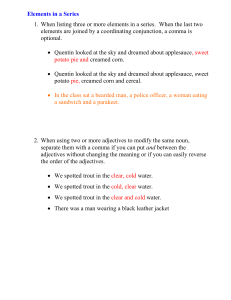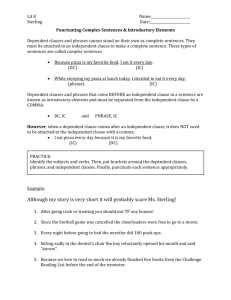BASIC RULES OF PUNCTUATION
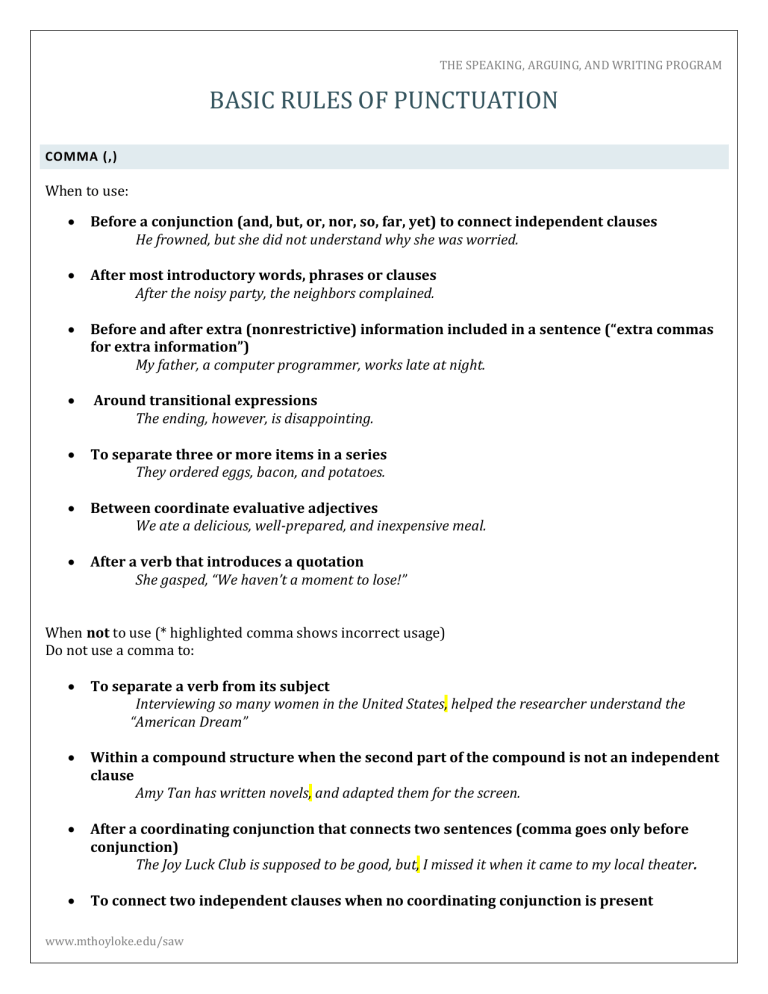
THE SPEAKING, ARGUING, AND WRITING PROGRAM
BASIC RULES OF PUNCTUATION
COMMA (,)
When to use:
Before a conjunction (and, but, or, nor, so, far, yet) to connect independent clauses
He frowned, but she did not understand why she was worried.
After most introductory words, phrases or clauses
After the noisy party, the neighbors complained.
Before and after extra (nonrestrictive) information included in a sentence (“extra commas for extra information”)
My father, a computer programmer, works late at night.
Around transitional expressions
The ending, however, is disappointing.
To separate three or more items in a series
They ordered eggs, bacon, and potatoes.
Between coordinate evaluative adjectives
We ate a delicious, well-prepared, and inexpensive meal.
After a verb that introduces a quotation
She gasped, “We haven’t a moment to lose!”
When not to use (* highlighted comma shows incorrect usage)
Do not use a comma to:
To separate a verb from its subject
Interviewing so many women in the United States, helped the researcher understand the
“American Dream”
Within a compound structure when the second part of the compound is not an independent clause
Amy Tan has written novels, and adapted them for the screen.
After a coordinating conjunction that connects two sentences (comma goes only before conjunction)
The Joy Luck Club is supposed to be good, but, I missed it when it came to my local theater .
To connect two independent clauses when no coordinating conjunction is present www.mthoyloke.edu/saw
THE SPEAKING, ARGUING, AND WRITING PROGRAM
Amy Tan has written novels, they have been adapted for the big screen. (Use semicolon instead)
To separate an independent clause from a following dependent clause introduced by after, before, because, if, since, unless, until, or when
The test results were good, because all the students had studied in groups.
To separate a clause beginning with “that” from the rest of the sentence
The girl in Tan’s story tried to convey to her mother, that she did not have to be a child prodigy.
Note: A comma can appear before a “that” clause when it is the second comma of a pair before and after extra information inserted as a nonrestrictive phrase.
He skates so fast, despite his size, that he will probably break the world record.
To separate a verb from its object or complement
The qualities required for the job are, punctuality, efficiency, and the ability to work long hours.
After “such as”
They bought kitchen supplies such as, detergent, paper towels, and garbage bags.
SEMICOLON (;)
Use a semicolon instead of a period when the ideas in two independent clauses are very closely connected and you want readers to expect more.
When to use
Connect two independent clauses with a semicolon to avoid a run-on sentence or a comma splice
Biography tells us about the subject; biographers also tell us about themselves.
To separate items in a list containing internal commas
When I cleaned out the refrigerator, I found chocolate cake, half-eaten; some canned tomato paste, which had a blue fungus growing on the top; and some possibly edible meat loaf.
Do not use
Semicolons interchangeably with colons.
They contributed a great deal of food; salad, chili and dessert. (Use a colon instead)
After an introductory phrase or dependent clause, even if the phrase or clause is long.
Because the training period was so long and arduous for all the players; the manager allowed one visit by family and friends. (Use a comma instead)
Note: Do not overuse semicolons. Use them in place of a period only when the link between the two independent clauses is strong. www.mthoyloke.edu/saw
THE SPEAKING, ARGUING, AND WRITING PROGRAM
COLON (:)
Colons serve two functions: (1) that a writer is introducing a quotation or a list of items and (2) that a writer is separating two clauses of which the second expands or illustrates the first.
When to use
After an independent clause to introduce a list
The students included three pieces of writing in their portfolios: a narrative, an argument, and a documented paper.
After an independent clause to introduce an explanation or elaboration
The author has performed a remarkable feat: she has maintained suspense to the last page .
Note: You may use a capital letter after a colon introducing an independent clause. Be consistent in your usage.
Do not use
Directly after a verb (such as a form of be or include )
The two main effects were: the improvement of registration and an increase in the number of advisers. (No punctuation necessary)
The book includes: a preface, an introduction, an appendix, and an index. (No punctuation necessary)
Directly after a preposition or “such as”
They packed many different items for the picnic, such as: salsa, pita bread and egg rolls. (No punctuation necessary)
DASH (—)
Dashes suggest a change of pace. They alert the reader to something unexpected, an interruption, or an abrupt change of thought. Form a dash by typing two hyphens, putting no extra space before, between, or after them.
Armed with one weapon—her wit—she faced the crowd.
The accused gasped, “But I never—” and fainted.
Commas can be used to set off appositive phrases, but dashes are preferable when the phrase itself contains commas.
The contents of her closet—lightweight shirts, shorts, and sandals—made her reassess her readiness for winter in New England.
Source Consulted: Raimes, Ann. Keys for Writers. Cengage Learning, 2004. Print.
www.mthoyloke.edu/saw


